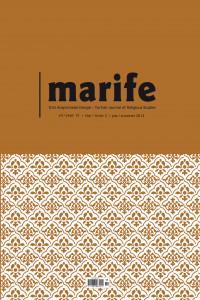Abstract
In the subject of creation of Quran, Ash’ariyyah and Maturidiyyah distinguished verbal discourse (revelation) and divine interior speech, which then did raise up the question of whether divine interior speech is audible or not. Divine interior speech is audible accord- ing to the most of the Ash’arites, while it is not audible according to the Maturidites in general. In this study, it was aimed to indicate that there is no concensus among the scholars of each school about audibility of divine interior speech, which is considered as one of the points of conflict between two schools. Besides, it was pointed out that the theologians, who acknowledge audibility of divine interior speech, did not mean detection by sense of hearing but direct understanding of the meaning by acknowledging audibility. According to other theologians, audibility of divine interior speech is totally different from ordinary audibility in the world and beyond the understanding which is based on detection of voice and letters
Abstract
Halku’l-kur’an konusunda Eş’ariyye ve Mâturîdiyye lafzî kelam – nefsî kelam ayrımına başvurmuş, bu ayrım da nefsî kelamın işitilebilir olup olmadığı sorusunu gündeme getirmiştir. Nefsî kelam çoğu Eş’arîlere göre işitilebilir; Maturîdilerin geneline göre ise işitilemez. Makalede Eş’ariyye ile Maturidiyye arasında ihtilaf noktalarından sayılan kelam-ı nefsinin işitilebilirliği noktasında her iki ekolun kendi içinde görüş birliği içinde olmadığı ortaya konacaktır. Ayrıca onun işitilebilirliğini kabul eden bazı kelamcıların bununla duyuyla algılamayı kastetmedikleri tespit edilecektir. Onların işitilebilir olma ile mananın doğrudan kavranmasını kastettikleri gösterilecektir. Diğerlerine göre ise kelam-ı nefsinin işitilmesi, bu dünyadakinden tamamen farklı, ses ve harfleri algılamanın ötesinde bir kavrayıştır
Keywords
Kelam mükellim halkulkur’an mahlûk harf ses kelam-ı nefsî sem’
Details
| Primary Language | Turkish |
|---|---|
| Subjects | Religion, Society and Culture Studies |
| Other ID | JA39YT86YB |
| Journal Section | Research Article |
| Authors | |
| Publication Date | August 31, 2013 |
| Published in Issue | Year 2013 Volume: 13 Issue: 2 |
This work is licensed under a Creative Commons Attribution-NonCommercial 4.0 International License.

